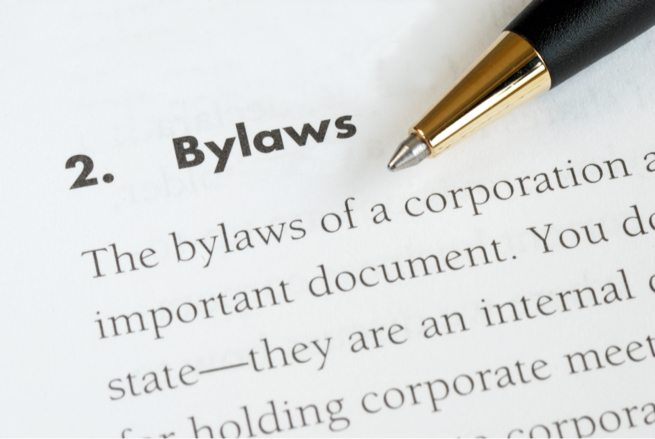All About Bylaws
All about bylaws--what they are and processes for changing them

What are bylaws?
Bylaws are the most important legal document of any organization, whether it is a corporation, association, or partnership.
Bylaws clearly outline in writing the day-to-day rules for an organization and provide comprehensive guidelines to keep things running smoothly. They establish how members are organized or the exact duties an organization expects from its managing members.
Bylaws outline the structure of an organization and may be customized to address the group’s specific needs.
Bylaws establish and protect the rights, and specify the duties and responsibilities of an organization's members, leadership, and others. They determine how those in charge are nominated or elected and they help settle any disputes among parties.
Finally, bylaws must be formally adopted and amended as necessary.
What do bylaws address?
Each set of bylaws will be specific to each organization, but the basic components of bylaws are as follows:
- An Organization's Name, Purpose, & Location
- Members
- Board of Directors and Officers
- Committees and Meeting
- Conflict of Interest
- Amending Bylaws

How are bylaws created?

Again, the creation process largely depends on the rules agreed upon by the leadership. However, most organizations follow this model:
-
Draft the bylaws, ensuring that the first draft includes articles covering the name and purpose of the organization, the stipulations and restrictions of membership and members, the rights and responsibilities of directors and officers, indemnification (protection against legal liability) of any board members, the governance of financial accounts and records, and a defined method of amending the bylaws in the future.
-
Secure the services of an attorney with experience in establishing the organizational structure of nonprofits. Have the attorney review the draft for content, language, and length. Expect to make significant edits before the final draft.
-
Present the final draft to the full board of directors for their review. After each member has reviewed the bylaws, they can then vote to approve the final draft.
-
Publish and circulate the bylaws to all relevant stakeholders (that is, any relevant party with an interest in the organization), board members, business leaders, and stockholders. One might also consider publishing the bylaws to the organizational website as a means of promoting an entity’s operational transparency to its participants, members, and regulators.
How are bylaws changed or amended?
Amending bylaws essentially changes the contract that has been made within the membership about how the organization operates, so it needs to be really technical and precise. The proper notice for a bylaw amendment contains three fundamental components:
- The proposed amendment, precisely worded
- The current bylaw
- The bylaw as it will read if the amendment is adopted
Preferably, the notice would include the proposers’ names and rationale for offering the amendment. It may also include other information such as whether a committee or board endorses or opposes the amendment.
When the time comes to deal with the amendment on the floor, it becomes subject to all the regular rules for that motion.
Bylaw Revision

A revision to bylaws is an extensive rewrite that often makes fundamental changes in the structure of the organization. By considering a revision of bylaws, the organization is proposing to substitute a new set of bylaws for the existing ones.
A group is free to amend anything in the proposed revision before it’s adopted as if the bylaws were being considered and adopted for the first time.
Voting on a Bylaw Amendment
Bylaw amendments, typically a quorum or majority vote, are handled as a rising vote unless the amendments are adopted by unanimous consent.
However, because of the importance of bylaws and the impact of their amendment, unless the vote is practically unanimous, one common procedure is to count the vote and record the result in the minutes.
Once the votes are tallied, the amended articles of incorporation will need to be filed with the state where the organization formed and the appropriate government office.
The state will normally provide a form to help organizations file amended articles of incorporation and may charge a fee.
Planning for Success
Bylaws give organizations a solid basis of rules and order to build and grow off of it. Having a clear organizational structure is critical for future success. Clearly defined processes and standards will prevent issues down the road.
Amending your bylaws? We're here to help.
Contact us to get started.